

Discover more from AutoMarketplace
🚕🌆 As NYC Congestion Tolling Advances, FHV Exemption Debate Reignites
NYC's Congestion Pricing plan received a key federal approval, facilitating its implementation by April 2024. Core focus of remaining debate will be about exemptions & final toll structure(s)
NYC’s Congestion Pricing crossed key threshold after federal government approval
Congestion tolling could be in place by April 2024
For-hire transportation (TLC) industry could be severely impacted IF exemption or carve-out not granted
We identify key decision makers & share our thoughts to help drivers and other TLC industry players advocate
Last week, the Federal Highway Administration (FWHA) said the Metropolitan Transit Authority’s (MTA) environmental assessment (EA) was sufficient. Essentially, NYC’s ‘Congestion Pricing’ plan (officially known as Central Business District Tolling Program) is getting closer to being implemented as various technical hurdles are passed.
Streetsblog USA, a site founded in 2006 that “covers the movement to end car dependence in the United States, and to facilitate a just transition to a transportation system”, provides a lot of detailed technical coverage of NYC’s Congestion Pricing plan.
According to Streetsblog NYC reporting:
The latest missive from the federal government signals the end of federal oversight of the traffic toll, and puts the execution of the project firmly in the hands of New York City, New York State and the Traffic Mobility Review Board, the six-member body that will hold public hearings to determine things like the actual price of the toll and who might be exempt from it.
“I call this the end of the beginning,” said Jon Orcutt, a former city Department of Transportation official. “Now the city and state and MTA really have to do it, and the TMRB has to meet and decide on prices, exemptions and map out implementation.”

🔑 Decision Makers
The MTA is governed by a 23 member board. Board members are nominated by New York’s governor, with four recommended by NYC’s mayor and one each by the county executives of Nassau, Suffolk, Westchester, Dutchess*, Orange*, Rockland*, and Putnam* counties (*Note: the members representing the latter four cast one collective vote). The Board also has six rotating non-voting seats held by representatives of organized labor and the Permanent Citizens Advisory Committee (PCAC).
The MTA is currently led by John (“Janno”) Lieber, who was appointed by New York Governor Kathy Hochul in January 2022. Mr. Lieber previously served as President of MTA Construction & Development, which is responsible for planning, developing, and delivering capital projects across the MTA.
Traffic Mobility Review Board (TMRB)
In late July 2022, the MTA appointed five of six members of the Traffic Mobility Review Board (TMRB), a key step before officially implementing congestion tolling. NYC Mayor Eric Adams also nominated John Samuelsen to the TMRB last year. Mr. Samuelson serves as international president of the Transport Workers Union (TWU) of America, AFL-CIO and is a non-voting member on the MTA Board.


Since the Federal Highway Administration (FHWA) has now approved NYC’s congestion tolling, the TMRB will develop recommendations for toll rates, as well as any credits, discounts, or exemptions and then present the recommendations to the MTA Board for consideration before the program is implemented.
Therefore, the two key decision making bodies for NYC congestion pricing are:
The 23 member MTA Board
The 6 member Traffic Mobility Review Board (TMRB), which includes current and former MTA Board members
“The TMRB will take into consideration traffic patterns, traffic mitigation measures, operating costs, vehicle types, public impact, public safety, peak and off-peak rates and environmental impacts. Accompanying their recommendations, the TMRB will provide a report…Ultimately, the MTA Board will determine the final toll structure after the TMRB’s recommendations. The recommendations must ensure collection of annual net revenues and fees necessary to fund at least $15 billion for the MTA’s 2020 to 2024 capital program”
- MTA
One additional note for the NYC TLC industry is the following:
Midori Valdivia, who was appointed to the MTA Board in June 2022 by Mayor Adams, was previously a Deputy Commissioner at the NYC Taxi & Limousine Commission (TLC)
Money & Politics
We know this all seems overwhelmingly bureaucratic. We also, along with any New Yorker that pays attention to City or State politics, know the MTA is essentially bankrupt and only survives via perpetual emergency funding. It seems like an obvious conflict of interest that a mismanaged bankrupt organization which stands to directly benefit from congestion tolling, is the same organization that decides the final congestion toll amount & structure 🤔. When this much money & politics are involved we would not expect anything less, but we’re going to call it out for our readers.
No matter how powerful the MTA Board and TMRB are, THEY ARE ANSWERABLE to New Yorkers and others, including New Jersey residents, who will be impacted by their decisions. No one should feel intimidated.
⭐⭐⭐⭐⭐⭐⭐⭐⭐⭐⭐
We urge NYC TLC Drivers and other industry participants to get educated (hopefully our coverage helps) on congestion pricing proposals and make your voices heard LOUD, CLEAR & REPEATEDLY.
This publication believes the concept of congestion pricing is a good idea and should be implemented within a very limited and specific framework. Right now the impact of many MTA proposals are too significant and broad, setting aside the fact that it’s coming from the MTA, an untrustworthy borrower asking, yet again, for more money.
We also believe in a strong, sustainable & WELL MANAGED public transport system. However, as we explain in detail later, high utilization TLC-regulated vehicles are (1) already taxed and charged for congestion, (2) have earned exemptions or caps, and (3) often compete with the MTA transit systems for ridership. For the MTA to decide on rules and regulations that will impact a direct transit competitor, is preposterous.
⭐⭐⭐⭐⭐⭐⭐⭐⭐⭐⭐
Who de we reach out to AutoMarketplace?
The simple answer is EVERYONE & ANYONE who will listen. The media, Uber, Lyft, driver advocacy groups, the Taxi & Limousine Commission, NYC Council members, members of the New York State Assembly, Senate and all the way up to the Governor’s office. This is your government and their job is to represent you.
What one must be careful of though, is some groups might be against congestion pricing in a way that doesn’t reflect many mainstream TLC industry views. For example, New Jersey residents may not want to pay any congestion tolls, while NYC TLC Drivers want to be exempt or pay it once a day - these are two very different viewpoints. Make sure you’re not arguing for something that you don’t actually agree with, although on the surface it may appear to be aligned advocacy.
Exemption Debate Reignites
Congestion pricing is a complex topic when it comes to contemplating how it might impact NYC’s for-hire transportation industry (a/k/a TLC industry).
On one hand, if yellow cabs and/or other NYC FHVs receive exemptions or have “capped” tolls per day (i.e., 1 per day), it can actually provide a boost 🥳 to the industry! In other words, it’ll be more expensive for personal vehicles to enter Central Manhattan below 60th Street (e.g., Central Business District).
On the other hand, if exemptions or tolls caps are not granted to TLC-regulated vehicles, it can potentially destroy 📉📉 trip demand, even the MTA concedes this! Whether the driver or passenger pays is a distracted technicality. Passenger fares will need to go up.
Below, we reshare a simplified summary of several official congestion tolling proposals from last year.
🙋♂️ Our Thoughts & Opinions
Below, we (re)share some of our thoughts and opinions on congestion pricing and the NYC TLC industry.
Point #1: Congestion Taxes, Minimum Pay Standards & FHV Supply Protection Mechanisms ALREADY Exist
Why are NYC TLC-licensed vehicles, which are high utilization and transport multiple passengers, facing ADDITIONAL ➕ congestion-related fees? 🤷♀️ NYC yellow cabs and FHVs are already paying congestion fees on *every* trip - $2.75 for FHVs and $2.50 for taxis.
Aggressive congestion tolling on taxis and FHVs runs the risk of double taxing NYC TLC vehicles, which could severely impact trip demand 📉📉📉, as passengers are ultimately paying the tolls, directly or indirectly. In addition, if you destroy trip demand in a way that is greater than the projected MTA revenue you would have otherwise generated with the status quo (or less harsh) congestion tolling regime, one may actually be creating flawed policy.
Yellow cab supply is already capped via the medallion system, with the City recently completing a major debt restructuring. Other FHV vehicle supply has been capped (‘TLC Plate Cap’) for the last four years (since August 2018). TLC minimum pay standards tied to utilization rates, coupled with the TLC Plate Cap, provides an additional layer of protection related to idling Ubers & Lyfts (HVFHVs) in Manhattan’s CBD.
Point #2: Congestion Pricing Should Target Private Vehicles
Private vehicle ownership continues to increase in NYC’s five boroughs for a host of reasons, one being safety concerns stemming from mismanaged MTA-run transportation networks.
It’s likely fair to assume privately owned vehicles:
Have much lower utilization rates than NYC taxis & FHVs
Account for large majority of occupied street parking space in Manhattan’s CBD (i.e., the % of NYC TLC drivers living in CBD is likely insignificant)
By increasing the costs of for-hire transportation alternatives, the MTA may counterintuitively promote MORE private vehicle 🚙 ownership within CBD.


Point #3: Exempting Yellow Cabs Is Fair Given Medallion Costs & Financial Stabilization Goals. Other FHVs Should Only Be Subjected To One Congestion Toll Per Day On Top of Status Quo Per Trip Congestion Fees
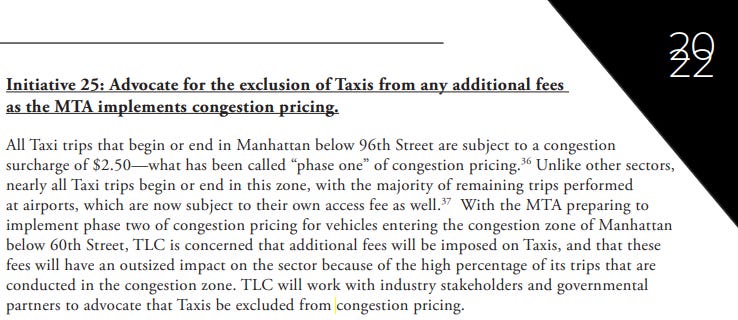
We think, as the NYC TLC ALREADY determined after intensive study, that exempting yellow cabs from congestion tolling is reasonable given:
The cost of a taxi medallion and the implied rights attached to that cost
The City’s effective obligation (e.g., City guarantee on taxi medallion debt) to stabilize the taxi medallion market
HOWEVER, as the TLC’s Black Car & Livery Task Force ALREADY determined after intensive study, yellow cabs cannot be overly advantaged via congestion toll exemptions vs. the FHV sector, which is a direct market competitor. In addition, a strong argument can be made that FHVs are a more effective customer service offering for those wanting a for-hire vehicle to commute from Manhattan CBD to non-CBD Manhattan or to outer boroughs and vice versa.

Point #4: MTA Competes With Taxis & FHVs
To be fair to the MTA, it appears the taxi and FHV competition point isn’t lost on them.


While most understand NYC should have a world class public transport system from the subway to buses to trains, etc - taxi and other TLC licensed for-hire vehicles (FHVs) are, to an extent, a rival transportation alternative.
The MTA cannot be allowed to tax a rival alternative in a manner that is anti-competitive.
MTA ridership is down due to a host of reasons from perceptions of safety to the rise of work from home (WFH), which has nothing to do with taxis or other FHVs. Making reference to pre-pandemic MTA statistics, is also not reasonable in making capital investment plans, so those probably need to be adjusted accordingly, which in turn would impact congestion toll pricing.
Attempting to increase public transport demand by making alternatives price uncompetitive is not a strategy that should be promoted and has obvious conflicts of interest. In addition, MTA’s financial history of running deficits and budget mismanagement, may lead to a situation where it drags down NYC’s FHV and taxi industry that employs, directly and indirectly, 100,000s of New Yorkers. It was already well understood that the TLC industry was playing its role in helping fund the MTA.
Furthermore, suggesting commercially licensed TLC drivers who face losing their livelihood, become bus drivers due to congestion pricing, is well…😤.
Uber, who is / was a huge financial supporter of promoting Manhattan congestion pricing, even seems to be surprised by the politics that has thus far played out! In the past, they’ve sent the below message to NYC drivers.
Final Thoughts (For Now)
Net-net we think congestion pricing conceptually is a good idea and should be implemented in Manhattan’s Central Business District (CBD). There is too much traffic caused by multiple vehicle (e.g., double parked delivery trucks) and non-vehicle (e.g., construction) factors in Manhattan’s core. In fact, one could argue that making it unattractive to drive or own a private vehicle in NYC would benefit the for-hire transportation market.
Another point worth mentioning is that we also expect EV exemptions for congestion tolling to come into play. However, we would be cautious before promoting such an exemption. More charging infrastructure needs to be built or you run the risk of prematurely incentivizing TLC drivers to invest in expensive EVs. Given the lack of affordable EV options and third party service network, we also think any future EV exemptions must be studied carefully based on ground realities vs. utopian ideals of what can exist.
‘Congestion Pricing’ and where final tolling and exemption decisions come out will have a consequential impact on the entire TLC industry. We’ll continue to cover this topic and encourage drivers and other industry players NOT to ignore its potential impact on NYC’s for-hire transportation market.
As always, let us know your thoughts in the comments section below or by emailing us at info@automarketplace.com.
AutoMarketplace NYC covers the for-hire transportation industry and automotive news. Check out AutoMarketplace on YouTube ▶️






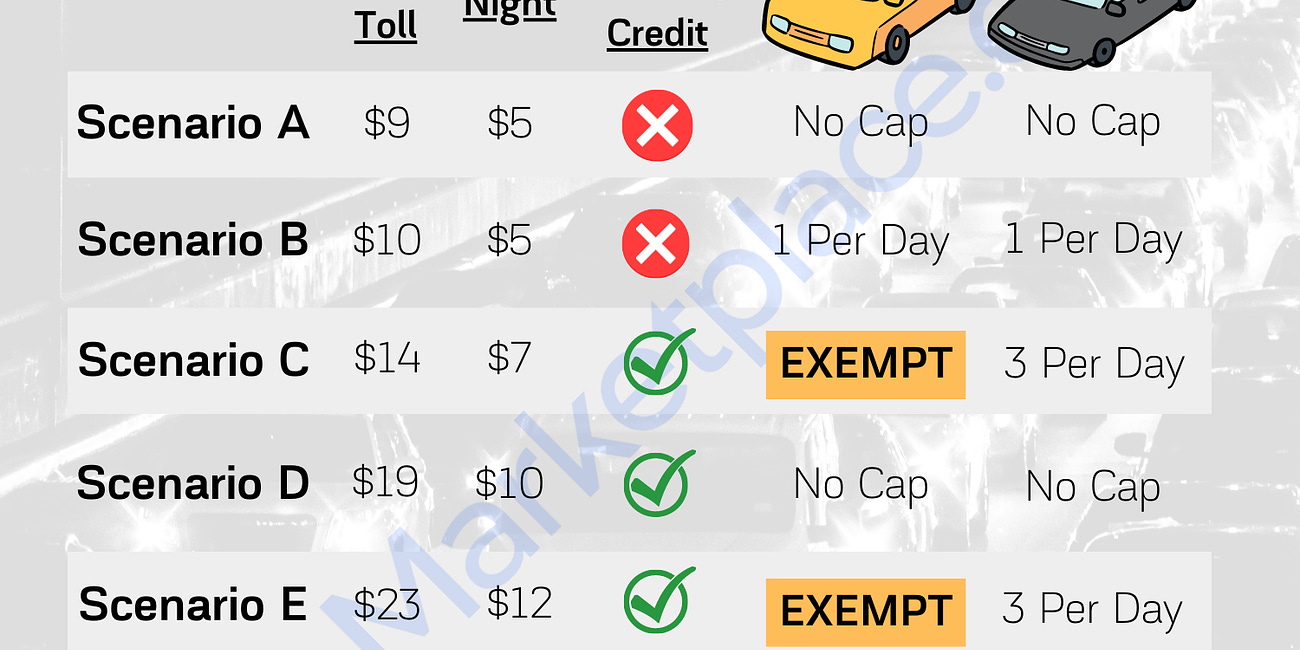
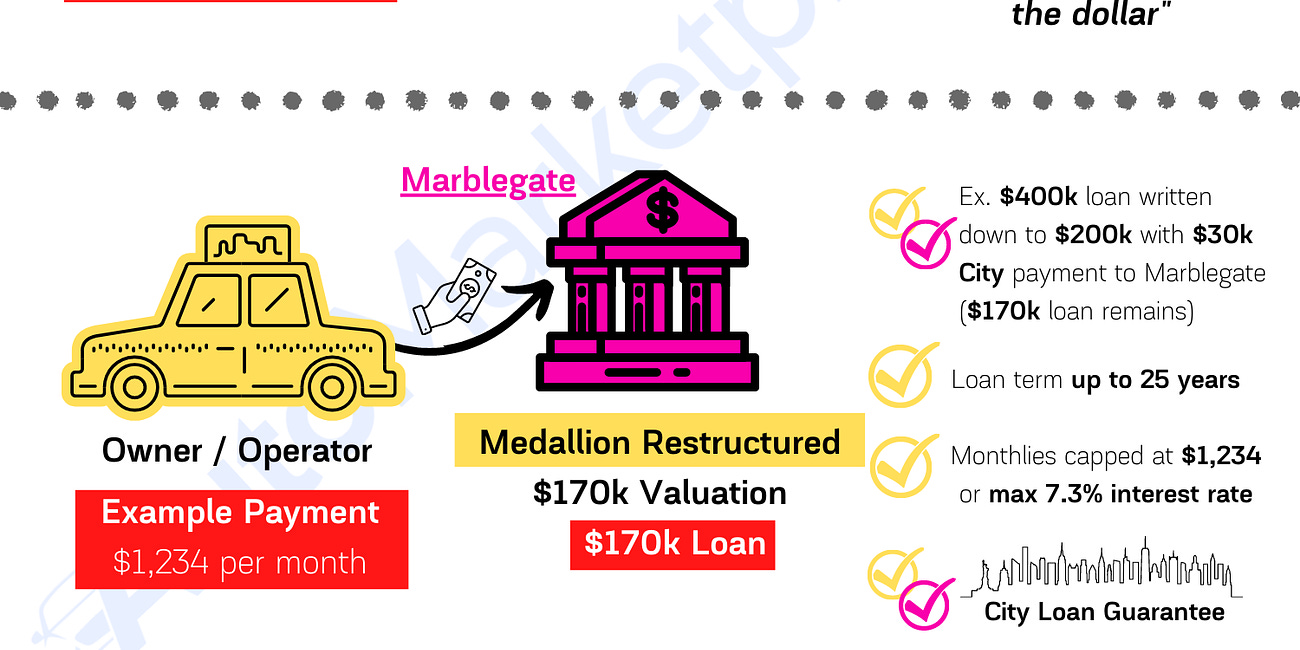
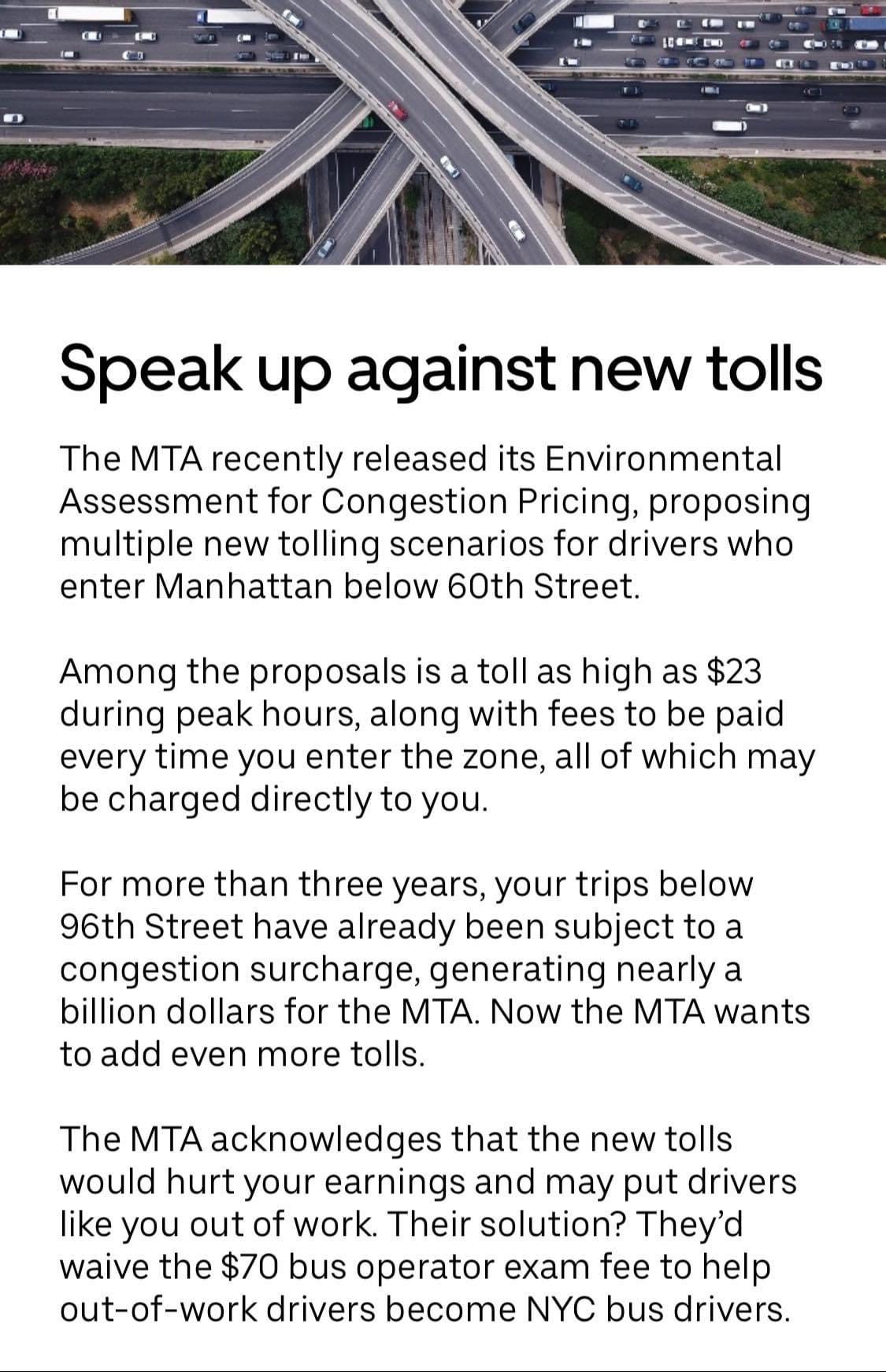


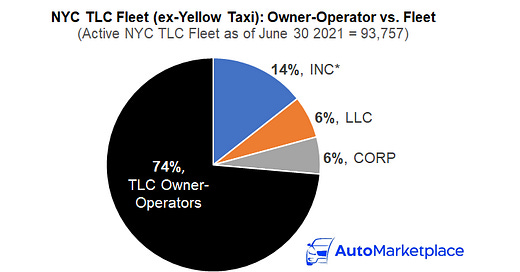



Black cars should be charged and taxis exempt. The medallion owners bought medallions, and the black cars did not. Buyers should be given rights I hope and since people who pay for something deserve more than the people who don’t I think it’s only fair to level the playing field by charging black cars
Again, the holy grail of the FHV industry is for black cars to be more expensive and luxurious and taxis should be the standard from point A to point B. That way black car drivers will make more because each fare will pay them more and taxis will be sustainable because they won’t have unfair competition. The only ones to lose would be the HV operators . They have enough anyway. They should make less bc they have more and share more with their drivers.